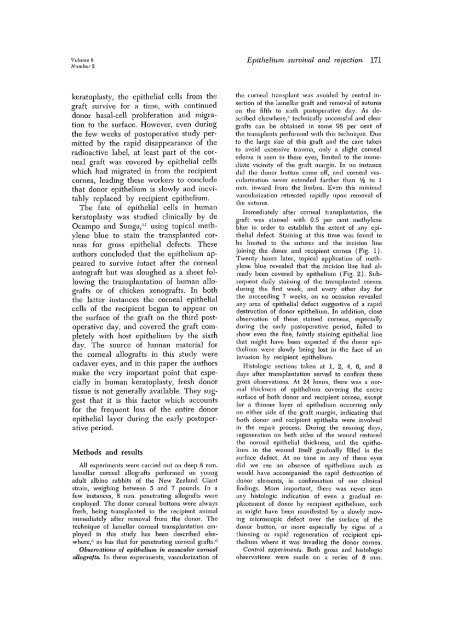The survival and rejection of epithelium in experimental corneal ...
The survival and rejection of epithelium in experimental corneal ...
The survival and rejection of epithelium in experimental corneal ...
You also want an ePaper? Increase the reach of your titles
YUMPU automatically turns print PDFs into web optimized ePapers that Google loves.
Volume 8<br />
Number 2<br />
Epithelium <strong>survival</strong> <strong>and</strong> <strong>rejection</strong> 171<br />
keratoplasty, the epithelial cells from the<br />
graft survive for a time, with cont<strong>in</strong>ued<br />
donor basal-cell proliferation <strong>and</strong> migration<br />
to the surface. However, even dur<strong>in</strong>g<br />
the few weeks <strong>of</strong> postoperative study permitted<br />
by the rapid disappearance <strong>of</strong> the<br />
radioactive label, at least part <strong>of</strong> the <strong>corneal</strong><br />
graft was covered by epithelial cells<br />
which had migrated <strong>in</strong> from the recipient<br />
cornea, lead<strong>in</strong>g these workers to conclude<br />
that donor <strong>epithelium</strong> is slowly <strong>and</strong> <strong>in</strong>evitably<br />
replaced by recipient <strong>epithelium</strong>.<br />
<strong>The</strong> fate <strong>of</strong> epithelial cells <strong>in</strong> human<br />
keratoplasty was studied cl<strong>in</strong>ically by de<br />
Ocampo <strong>and</strong> Sunga, 17 us<strong>in</strong>g topical methylene<br />
blue to sta<strong>in</strong> the transplanted corneas<br />
for gross epithelial defects. <strong>The</strong>se<br />
authors concluded that the <strong>epithelium</strong> appeared<br />
to survive <strong>in</strong>tact after the <strong>corneal</strong><br />
autograft but was sloughed as a sheet follow<strong>in</strong>g<br />
the transplantation <strong>of</strong> human allografts<br />
or <strong>of</strong> chicken xenografts. In both<br />
the latter <strong>in</strong>stances the <strong>corneal</strong> epithelial<br />
cells <strong>of</strong> the recipient began to appear on<br />
the surface <strong>of</strong> the graft on the third postoperative<br />
day, <strong>and</strong> covered the graft completely<br />
with host <strong>epithelium</strong> by the sixth<br />
day. <strong>The</strong> source <strong>of</strong> human material for<br />
the <strong>corneal</strong> allografts <strong>in</strong> this study were<br />
cadaver eyes, <strong>and</strong> <strong>in</strong> this paper the authors<br />
make the very important po<strong>in</strong>t that especially<br />
<strong>in</strong> human keratoplasty, fresh donor<br />
tissue is not generally available. <strong>The</strong>y suggest<br />
that it is this factor which accounts<br />
for the frequent loss <strong>of</strong> the entire donor<br />
epithelial layer dur<strong>in</strong>g the early postoperative<br />
period.<br />
Methods <strong>and</strong> results<br />
All experiments were carried out on deep 8 mm.<br />
lamellar <strong>corneal</strong> allografts performed on young<br />
adult alb<strong>in</strong>o rabbits <strong>of</strong> the New Zeal<strong>and</strong> Giant<br />
stra<strong>in</strong>, weigh<strong>in</strong>g between 5 <strong>and</strong> 7 pounds. In a<br />
few <strong>in</strong>stances, 8 mm. penetrat<strong>in</strong>g allografts were<br />
employed. <strong>The</strong> donor <strong>corneal</strong> buttons were always<br />
fresh, be<strong>in</strong>g transplanted to the recipient animal<br />
immediately after removal from the donor. <strong>The</strong><br />
technique <strong>of</strong> lamellar <strong>corneal</strong> transplantation employed<br />
<strong>in</strong> this study has been described elsewhere,<br />
5 as has that for penetrat<strong>in</strong>g <strong>corneal</strong> grafts. 0<br />
Observations <strong>of</strong> <strong>epithelium</strong> <strong>in</strong> avascular <strong>corneal</strong><br />
allografts. In these experiments, vascularization <strong>of</strong><br />
the <strong>corneal</strong> transplant was avoided by central <strong>in</strong>sertion<br />
<strong>of</strong> the lamellar graft <strong>and</strong> removal <strong>of</strong> sutures<br />
on the fifth to sixth postoperative day. As described<br />
elsewhere, 5 technically successful <strong>and</strong> clear<br />
grafts can be obta<strong>in</strong>ed <strong>in</strong> some 98 per cent <strong>of</strong><br />
the transplants performed with this technique. Due<br />
to the large size <strong>of</strong> this graft <strong>and</strong> the care taken<br />
to avoid excessive trauma, only a slight <strong>corneal</strong><br />
edema is seen <strong>in</strong> these eyes, limited to the immediate<br />
vic<strong>in</strong>ity <strong>of</strong> the graft marg<strong>in</strong>. In no <strong>in</strong>stance<br />
did the donor button come <strong>of</strong>f, <strong>and</strong> <strong>corneal</strong> vascularization<br />
never extended farther than Vz to 1<br />
mm. <strong>in</strong>ward from the limbus. Even this m<strong>in</strong>imal<br />
vascularization retreated rapidly upon removal <strong>of</strong><br />
the sutures.<br />
Immediately after <strong>corneal</strong> transplantation, the<br />
graft was sta<strong>in</strong>ed with 0.5 per cent methylene<br />
blue <strong>in</strong> order to establish the extent <strong>of</strong> any epithelial<br />
defect. Sta<strong>in</strong><strong>in</strong>g at this time was found to<br />
be limited to the sutures <strong>and</strong> the <strong>in</strong>cision l<strong>in</strong>e<br />
jo<strong>in</strong><strong>in</strong>g the donor <strong>and</strong> recipient cornea (Fig. 1).<br />
Twenty hours later, topical application <strong>of</strong> methylene<br />
blue revealed that the <strong>in</strong>cision l<strong>in</strong>e had already<br />
been covered by <strong>epithelium</strong> (Fig. 2). Subsequent<br />
daily sta<strong>in</strong><strong>in</strong>g <strong>of</strong> the transplanted cornea<br />
dur<strong>in</strong>g the first week, <strong>and</strong> every other day for<br />
the succeed<strong>in</strong>g 7 weeks, on no occasion revealed<br />
any area <strong>of</strong> epithelial defect suggestive <strong>of</strong> a rapid<br />
destruction <strong>of</strong> donor <strong>epithelium</strong>. In addition, close<br />
observation <strong>of</strong> these sta<strong>in</strong>ed corneas, especially<br />
dur<strong>in</strong>g the early postoperative period, failed to<br />
show even the f<strong>in</strong>e, fa<strong>in</strong>tly sta<strong>in</strong><strong>in</strong>g epithelial l<strong>in</strong>e<br />
that might have been expected if the donor <strong>epithelium</strong><br />
were slowly be<strong>in</strong>g lost <strong>in</strong> the face <strong>of</strong> an<br />
<strong>in</strong>vasion by recipient <strong>epithelium</strong>.<br />
Histologic sections taken at 1, 2, 4, 6, <strong>and</strong> 8<br />
days after transplantation served to confirm these<br />
gross observations. At 24 hours, there was a normal<br />
thickness <strong>of</strong> <strong>epithelium</strong> cover<strong>in</strong>g the entire<br />
surface <strong>of</strong> both donor <strong>and</strong> recipient cornea, except<br />
for a th<strong>in</strong>ner layer <strong>of</strong> <strong>epithelium</strong> occurr<strong>in</strong>g only<br />
on either side <strong>of</strong> the graft marg<strong>in</strong>, <strong>in</strong>dicat<strong>in</strong>g that<br />
both donor <strong>and</strong> recipient epithelia were <strong>in</strong>volved<br />
<strong>in</strong> the repair process. Dur<strong>in</strong>g the ensu<strong>in</strong>g days,<br />
regeneration on both sides <strong>of</strong> the wound restored<br />
the normal epithelial thickness, <strong>and</strong> the <strong>epithelium</strong><br />
<strong>in</strong> the wound itself gradually filled <strong>in</strong> the<br />
surface defect. At no time <strong>in</strong> any <strong>of</strong> these eyes<br />
did we see an absence <strong>of</strong> <strong>epithelium</strong> such as<br />
would have accompanied the rapid destruction <strong>of</strong><br />
donor elements, <strong>in</strong> confirmation <strong>of</strong> our cl<strong>in</strong>ical<br />
f<strong>in</strong>d<strong>in</strong>gs. More important, there was never seen<br />
any histologic <strong>in</strong>dication <strong>of</strong> even a gradual replacement<br />
<strong>of</strong> donor by recipient <strong>epithelium</strong>, such<br />
as might have been manifested by a slowly mov<strong>in</strong>g<br />
microscopic defect over the surface <strong>of</strong> the<br />
donor button, or more especially by signs <strong>of</strong> a<br />
th<strong>in</strong>n<strong>in</strong>g or rapid regeneration <strong>of</strong> recipient <strong>epithelium</strong><br />
where it was <strong>in</strong>vad<strong>in</strong>g the donor cornea.<br />
Control experiments. Both gross <strong>and</strong> histologic<br />
observations were made on a series <strong>of</strong> 8 mm.
















